
Are you interested in turning your acoustic guitar into an acoustic/electric guitar without the high prices of commercial products? Looking for a fun project where you can customize the sound to make your guitar exactly how you like it? With the help of a few cheap parts you can pick up at your local electronic store, you can design, construct and use your own acoustic guitar pickup.
Contents:
Making the Pickup
Specifications
Installation
Audio Samples
Making the Pickup ^contents^
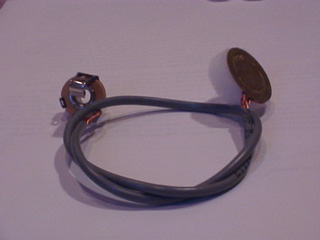
Parts you will need:
1. Piezo Buzzer Element
2. about 1 foot of shielded audio cable
3. a 1/4" audio jack (that can be mounted on the guitar body)
4. a small amount of medium density foam. (just a couple square inches)
5. soldering iron, solder, wire strippers, hot glue gun, and hot glue
- The first step is to design and create your pickup. The heart of the pickup is a piezo buzzer element. You can find these for just a couple dollars at your local parts store. (Radio Shack) Sometimes the Piezo Buzzer packages don't have that much information on them, but you want to find things as close as possible to the information listed on the "Specs:" page. In other words, they are pretty cheap so go for a good one. Also note that you do not need a fully functional buzzer device... just the Piezo element.
- A word about Piezo Elements. Piezo elements are made from two conductors separated by a layer of piezo crystals. When a voltage is applied across the crystal layer, the crystals pull on one side and push on the other. This in turn bends the metal conductor layers. When a sinusoidal signal (audio) is applied, the conductors are pushed and pulled very quickly, creating sound waves. The beauty of the Piezo element is that it also can be applied reversely. If sound waves push and pull on the conductors, an electrical signal is created and can be output to an amplifier or recording device. This is exactly how we will use the Piezo Buzzer element in this project. It will be attached to the inside of the guitar body, and, as the body vibrates, the sound will be turned into an electric signal by the Piezo buzzer element.
- Now that you have the Piezo Buzzer, you need to carefully break it open and get out the piezo element. Be careful not to hurt the metal device inside. Bending the element may cause it to break or lose some of it's sensitivity.
- You are now ready to solder the device together. Strip the ends of the shielded audio cable. On one end connect the signal wire to the center of the Piezo element and the ground/shielding to the metal/brass surface of the piezo element. On the other end of the shielded wire, connect the signal wire to the signal tab on the 1/4" audio jack and connect the shielding to the ground tab.
- We have found that a small piece of medium density foam improves the performance of the pickup over a large number of frequencies.(If you are familiar with circuitry, feel free to experiment with combinations of capacitors and resistors to cut undesired frequencies) Cut a piece of foam the same size of your piezo element and about 3/8" tall. Place a large drop of hot glue on the back side of the piezo element (where the wires connect) and then press the foam on until the glue cools.
- Your piezo pickup device should now be ready to install. You may want to make sure it is working by plugging it into an amp and lightly tapping on it.
Specifications: ^contents^
| Transducer Type: | Piezo-electric |
| Transducer Size: | 1.1" |
| Audio Range: | 106 dB |
| Noise Level | less than -111 dB |
| Output: | 1/4" Female Audio Jack |
| Wiring: | High quality shielded audio cable |
| Installation Time: | about 1 Hour |
Comparison Spectrums
Using audio data software, spctrum curves were produced to show the differences between my pickup and pickups installed in name brand guitars. Click on the graphs below to enlarge them.
The first graph shows a guitar with my pickups installed vs. an Alvarez Yari 12 string (This guitar is a professional model and has individual pickups for each couplet of strings. That's 6 pickups in all), and a Fender Stratocaster. The Fender Strat. is included because it is known for its full vintage sound with professional pickups.
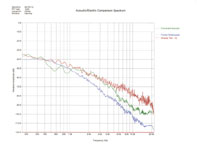
The second graph shows the difference between our piezo pickup and a generic piezo pickup installed on a guitar.
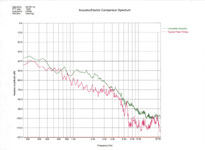
This is why it is important to choose wisely from all of the parts at your local electronics store. Getting a piezo element with the specs above will help to get you on the curve we obtained from our pickup, making sure you get a full, rich sound every time you plug-in.
Installation: ^contents^
STEP #1.
The first step is to get all of you supplies together. This is what you will need to turn your acoustic guitar into and acoustic/electric guitar.
- 1 Piezo-electric transducer pickup. (The main part)
- 1 Electric drill.
- 1 3/8" drill bit. (Use a spade bit)
- 1 Roll of double-stick tape / or hot glue (recommended) / or sticky putty
- 1 Roll of masking tape.
STEP #2.

Figure 1
The second step is to mark where the hole will be in the body of the guitar. Unless you are handy with a soldering iron and have an endpin-jack on-hand, do not place your hole in the end of the guitar. This is where the pin that holds the strap is located. There is a block of wood there and the provided jack will not work in this position. I recommend marking the hole about halfway through the curve on the end of the guitar. It is, however, up to you where you choose to put it. Be creative! You will probably want to mark the spot with pencil first, then take the tip of the drill bit and twist on the mark by hand (not in the drill) to make a small indentation in the wood, as seen in Figure 1. Endpin jacks are a stronger and more professional solution, but will also probably double the cost of this project for you.
STEP #3.

Figure 2
Next we must drill the hole. This is the most difficult part of the installation process. It is in your best interest to take the tension off of the strings to get rid of forces that may be pulling on the wood. You may want to practice drilling holes on a scrap piece of wood if available to get a feel for the drill. Using a good sharp 3/8" spade bit, as seen in Figure 2, very slowly (fast drill speed, very little pressure) and carefully drill the hole in the body. Be steady and smooth or you may cause the body of the guitar to splinter around the hole.
STEP #4.
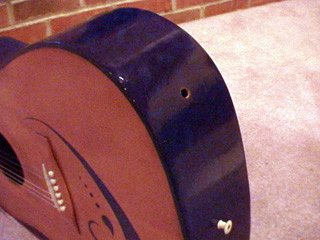 |
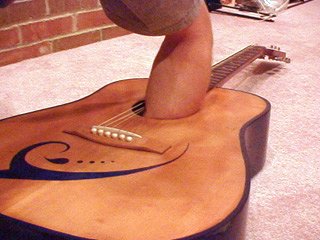 |
Carefully clean the edges of the hole, shown in Figure 3. Take the washer and nut off of the 1/4" jack. You must now feed the jack into the guitar body and direct it towards the hole you just drilled. Depending on the size of your hand, you may need to take the strings completely off to get your hand in far enough to guide the jack towards the hole. I usually just loosen the strings, (very loose) and squeeze my hand in as far as it will go, as seen in Figure 3b. It is almost certain that you will not be able to reach the drilled hole. This is okay. Just be patient and keep fishing for it. You may find it helpful to use something such as a paperclip or a pencil to help guide you through the hole. Once it is through, put the washer and nut back onto the jack to hold it in place. Do not overtighten the nut. Make it too loose and it will come off... Make it too tight and you will have a guitar with a crack in it... A little loose is better than too tight! If you are worried about the strength of the jack in the side of the guitar, you can easily make a sheet-metal washer for the inside of the guitar to help support it.
STEP #5.

Figure 4
This step is a very important part if you want your guitar to have a nice sound. You are now going to mount the piezo element. Be careful with the element. Piezo pickups can be broken if you bend them. Although it may seem odd, your pickup will produce a much better sound if you mount it hanging off of the guitar, 50-50. In other words, half of the element (brass side) is taped to the bridge (or a brace), and the other half is hanging out in mid-air. The best place to mount the piezo element is on the back side of the bridge. (the side towards the endpin) To apply the pickup, take a piece of double-stick tape, just enough to cover half of the element, and place it on the element. You may also want to use hot glue once you have found the best place on the guitar, as this improves the .4k-1.0kHz range of the pickup. A lot of people also use a sticky-putty, available at a local office supply store. The half of the pickup with tape (or glue or putty) will be the part that sticks to wood on the inside of the guitar (see Figure 4). The other half will be hanging off. Try to keep the adhesive (tape/hot glue/putty) as thin as possible as this will help overall performance. It is also important to note that the placement of the piezo element can also be used to boost frequencies from .25-3.0kHz depending on how much of the device hangs in mid-air. Play around with different placements if you want your guitar to have a unique sound. Typically, the closer the pickup is to the bridge, the warmer the sound.
STEP #6.
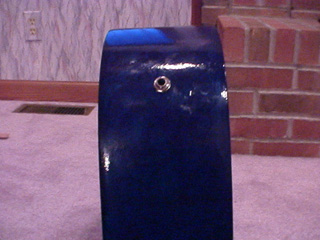
Figure 5
The hard part of the installation is over. Now for the finishing touches. First, you must secure the loose wire that runs from the pickup to the jack so that it does not flop back-and-forth when someone you the guitar. Go in through the sound-hole and place generous pieces of masking tape to secure the wire. Next you may want to snug the nut on the jack to finalize its placement. Then tighten up the strings and plug it in! That's it. You just made your acoustic guitar into an acoustic/electric!
Audio Samples ^contents^
I recorded some audio samples using my homemade acoustic pickup. Please realize that I'm not a professional guitarist, but these samples will let you hear how nice the pickup really sounds. Check out the installation section for ways to add more bass or more treble to the tone.
All samples are in MP3 format.
| Chords | Click Here to Listen (250k) |
| Solo | Click Here to Listen (200k) |
| Harmonics | Click Here to Listen (225k) |
| Blues Riff | Click Here to Listen (259k) |